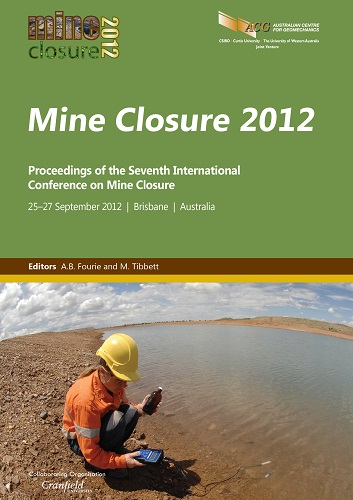Long term closure planning for an evolving mine site – a case study of Newmont Boddington Gold Mine in Western Australia

|
Authors: De Sousa, K; Amoah, N |
DOI https://doi.org/10.36487/ACG_rep/1208_24_Amoah
Cite As:
De Sousa, K & Amoah, N 2012, 'Long term closure planning for an evolving mine site – a case study of Newmont Boddington Gold Mine in Western Australia', in AB Fourie & M Tibbett (eds), Mine Closure 2012: Proceedings of the Seventh International Conference on Mine Closure, Australian Centre for Geomechanics, Perth, pp. 251-264, https://doi.org/10.36487/ACG_rep/1208_24_Amoah
Abstract:
Newmont Boddington Gold (NBG) mine is located 12 km northwest of the town of Boddington and about 120 km southeast of Perth in Western Australia (WA). Open pit mining of an oxide gold resource commenced at the operations in 1987. In 2008, NBG undertook an expansion program to increase future gold production to one million ounces per annum, potentially becoming the largest gold mine in Australia. Critical to the life cycle of such a large mining operation is the need to ensure that mine closure is well planned in advance and consistently managed throughout operation to minimise future liabilities. For example, the large quantities of waste (waste rock estimated to be over one billion tonnes over the life of the mine), vast open pits and areas for tailings storage and site operational facilities, geographically and ecologically sensitive location and socio-economic issues will all become significant legacy factors during mine closure and post closure stages. To mitigate closure liabilities, Newmont’s internal guidelines have strict requirements for the development and review of closure plans at all stages of mine life with annual analyses of closure liability costs. This is to ensure consistency with life of mine (LOM) plans, changes in operations, stakeholder expectations, regulatory requirements etc. However, planning and managing closure for such a large, complex and evolving mine poses challenges. The recent changes to the mine closure planning guidelines in WA, rapidly changing community expectations and Newmont’s growth plans add to the complexities. The paper discusses the on-going activities for an integrated life of mine and closure planning approach that will ensure that operational decisions are consistent with closure requirements and environmentally sustainable operation of the mine to minimise long-term liabilities. How recent closure planning activities have assisted in optimising the design and operation of the expanded mine, especially in the areas of waste rock landform location, size and capping will be presented. Closure planning activities such as knowledge gap analysis, risk analysis-based approach to prioritising activities and development of completion criteria as well as current studies and investigations to address knowledge gaps in waste rock geochemistry, post closure facilities management, closure water management, rehabilitation trials, tailings decommissioning plans, closure cost estimating and financial provisions for closure liabilities are discussed.
References:
Amoah, N., Haymont, R. and Campbell, G. (2010) Benefits of Timely and Valid Geochemical Characterisation of Mine Waste for Life of Mine and Closure Planning, A Case Study of Newmont Boddington Gold Mine in Western Australia, in Proceedings of the 14th International Conference on Tailings and Mine Waste, Tailings and Mine Waste 2010, Vail, Colorado, USA, 17–20 October 2010, pp. 253–262.
Bentel, G.M. (2009) Key Closure Planning Considerations, in Proceedings Fourth International Conference on Mine Closure (Mine Closure 2009), A.B. Fourie and M. Tibbett (eds), 9‒11 September 2009, Perth, Australia, Australian Centre for Geomechanics, Perth, pp. 41–54.
Campbell, G., Haymont, R. and Amoah, N. (2012) A Testing Approach to Assess the Weathering Behaviour of Lithotypes Characterised by a Trace-sulphide/Carbonate-deficient Mineralogy: Application to Altered Andesites/Diorites at the Boddington Gold Mine, Western Australia, in Proceedings 9th International Conference on Acid Rock Drainage, W.A. Price, C. Hogan, G. Tremblay (eds), 20–26 May 2012, Ottawa, Canada (in print).
Cochrane, H.R. and Aylmore, L.A.G. (1997) Assessing Management-Induced Changes in the Structural Stability of Hardsetting Soils, Soil and Tillage Research, Elsevier, Vol. 20, pp. 123–132.
DMP and EPA (2011) Department of Mines and Petroleum; Environmental Protection Authority. Guidelines for Preparing Mine Closure Plans, Perth, Western Australia, June, 78 p.
Environmental Protection Authority (2006) Guidance for the Assessment of Environmental Factors (in accordance with the Environmental Protection Act 1986), Rehabilitation of Terrestrial Ecosystems No. 6, Perth, Western Australia, 37 p.
Jasper, D.A. and Braimbridge, M.F. (2006) Waste Characterisation for Optimal Landforms, in Proceedings GEMG Conference, 24–26 May 2006, Kalgoorlie, Australia, Goldfields Environmental Management Group, Kalgoorlie, pp. 128–145.
Lacy, H. and Barnes, K. (2006) Tailings Storage Facilities; Decommissioning Planning is Vital for Successful Closure, in Proceedings First International Seminar on Mine Closure (Mine Closure 2006), A.B. Fourie and M. Tibbett (eds), 13‒15 September 2006, Perth, Australia, Australian Centre for Geomechanics, Perth, pp. 139–148.
© Copyright 2025, Australian Centre for Geomechanics (ACG), The University of Western Australia. All rights reserved.
View copyright/legal information
Please direct any queries or error reports to repository-acg@uwa.edu.au
View copyright/legal information
Please direct any queries or error reports to repository-acg@uwa.edu.au